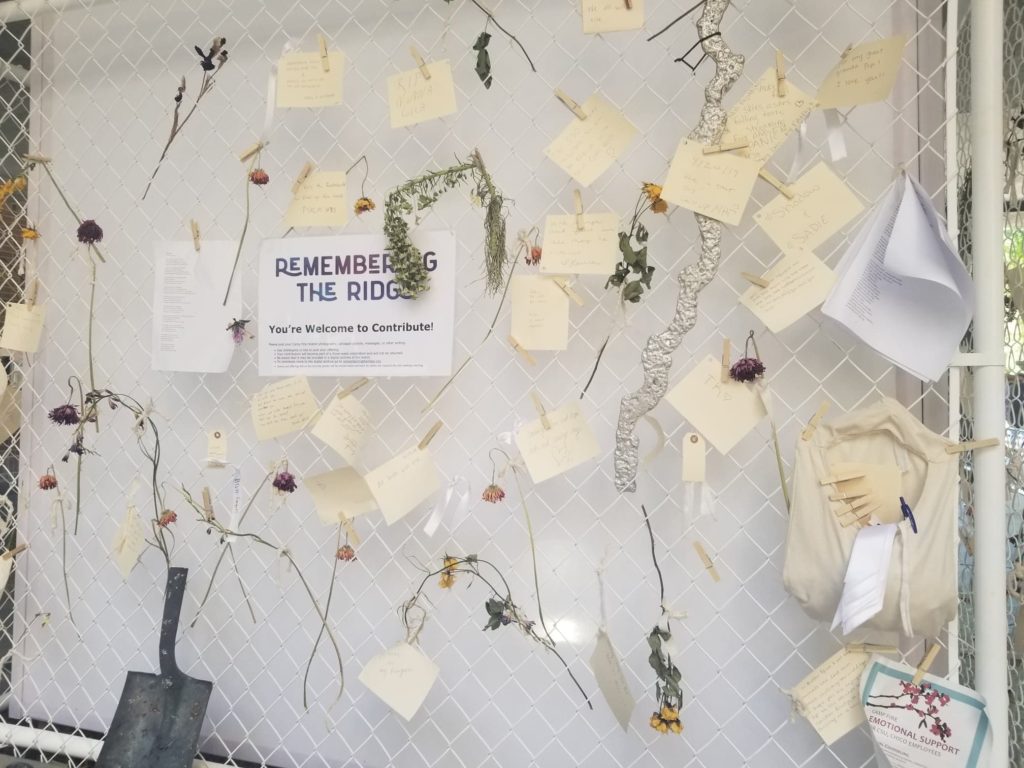Six months after the Camp Fire destroyed the neighboring towns on the ridge, the students at Chico State are aware of how the fire changed the entire town. They talk about how housing for the next school year is harder to find, and that people drive way too fast through town now.
“It feels like it’s normal, but I know for other people around me, their whole lives just changed,” said Sophie Gruszka.
On Nov. 6, 2018, life was supposed to continue like any other day for the college students at Chico State, a public university in the California State University system. But even though the fire didn’t touch the town of Chico, the students still felt the devastation reach them in their college town.
Gruszka, along with Clare Brady, Sandra Canizal and Malia Esteban were all attending classes at Chico State on Nov. 6.
“The day it started, there was a lot of smoke, and I remember being like, “Oh they’ll put it out soon enough,’” said Gruszka.

As the fire was raging through the ridge above, students were hearing rumors about the fire. Some students were encouraging their classmates to leave, while some just assumed this was just another California wildfire.
“I was receiving two different messages,” said Brady. “From the students, it was a little chaotic.”
At 9 a.m., the first official notification from the university went out. It alerted students to the fire that was being monitored on the ridge, but classes would still continue for the day. Updates continued throughout the day. At around 11:15 a.m., the university was still open. By that time, Paradise had been burning for hours.
Near 3 p.m., classes for the rest of the day were canceled, but the university released the information that, “Campus remains open. Classes are expected to resume tomorrow, Nov. 9,” according to the Chico State updates from the Camp Fire.
While the university was preparing for class the next day, a lot of the students were trying to find a way out of town. Many of the students at Chico State are from different areas in California, including Gruszka, Brady, Canizal and Esteban.
“It was kind of scary because I didn’t have anywhere to go home,” said Gruszka.
Students piled into cars with their roommates, friends or others who lived nearby. Some students had their plane tickets changed, as their Thanksgiving break was only two weeks away.

Canizal is from Southern California and had no clue what she was going to do until Gruszka offered her a ride to her home, which was closer to Chico. She had her flight switched and all the fees were waved so she could get home.
At about 5:40 p.m. on Nov. 9, a day after the fire had started, classes were canceled at Chico State until Nov. 26. By this point, a number of students had already left the area, fleeing to their homes if they were safe.
“When I was home, I was literally checking the progress of the fire every day, like every hour,” said Gruszka.
As students came back to campus after the two weeks off from school, their lives had changed, even as their town of Chico was untouched.
“When I came back, all I wanted to do in my classes was just like share my story and hear other people’s stories and cope with everybody,” said Brady.
The young women talked about how their lives felt so different after the fire. Coming back to Chico had affected each of them, even though they were lucky to not have to be directly impacted by the fire.
Esteban received a new roommate after the fire; another Chico State who had been living in Paradise. She lost her home in the fire.
As many were returning to the area, students and residents in the area were encouraged to wear masks because of the air quality. The smoke had been so bad that it even affected those living in the Bay Area.
“I wore the same one for like two weeks,” said Brady.
Even months after the fire, at the university, the fire hasn’t been forgotten. Outside of the main entrance to the library, two square support columns have been wrapped in fencing material. Tied to the fences are flowers, flyers and notes from students affected by the fire and words of encouragement from others. Some strips of paper say, “Butte Strong,” or “California Strong.”
One of the more shocking pieces on the fence is a burnt, brown leather purse. Stories of barely making it out of the fire are told on the cream-colored parchment. A reminder of how close the fire was for so many on campus.
The remembrance outside of the library was called “Remembering the Ridge.” It was part of a three-week installation to remember how the fire affected the campus on the five-month anniversary. Students and staff could contribute to the physical site itself or contribute their stories and memories on the website created for the installation.
The girls, who were all sitting at a coffee shop, talking about classes and their volunteer work, much of which helped the Camp Fire victims, look like any other group of college students around the country. The Camp Fire comes up in conversation just as naturally as any other topic related to school.
“I feel like the community has experienced it, is mentally recovering from it,” said Brady. “Nobody really talks about it.”
But the memories are still there. The impact is still lasting on the campus at Chico State. For these students and many others, the Camp Fire will be part of their college experience, one that’s full of tragedy and worry.
For more information about Remembering the Ridge and to read some of the online stories, visit rememberingtheridge.org.